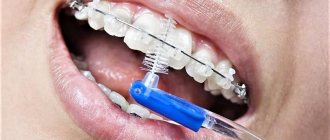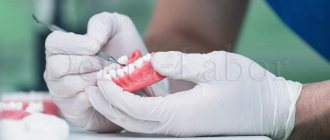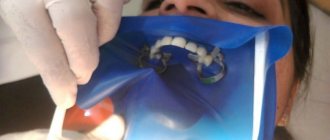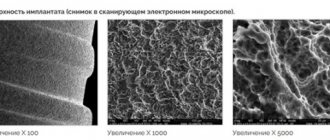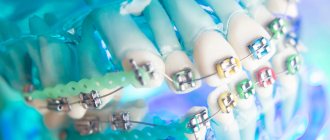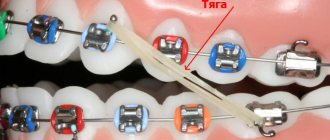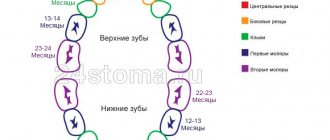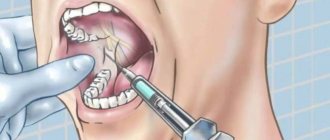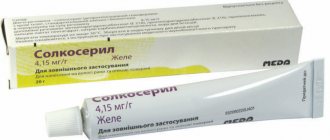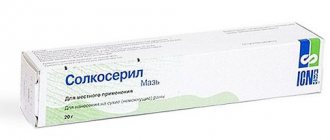Many orthodontists consider childhood to be the most appropriate age for correcting the position of teeth that have erupted and are just beginning to emerge, and for correcting malocclusion. This is due to the fact that the child’s jaw is still developing, so in a short time it is possible to correct existing defects and prevent the situation from getting worse. The most common reason for a child’s malocclusion is the lack of attention to this problem on the part of his mother. It is normal for a child to have a lower jaw that is smaller than the upper jaw, but during natural feeding this defect is usually corrected.
Many orthodontists consider childhood to be the most appropriate age for correcting the position of teeth that have erupted and are just beginning to emerge, and for correcting malocclusion.
The main causes of malocclusion:
- The hole in the nipple is too large (with artificial feeding). The child does not need to make any effort to obtain food and the jaw does not work or develop.
- Lack of roughage in the diet;
- Lack of minerals and vitamins in the body;
- Mouth breathing due to problems with blocked sinuses.
However, all this is not an insurmountable obstacle to getting a child a beautiful smile with straight teeth.
The most common reason for a child’s malocclusion is lack of attention from his mother.
Orthodontic equipment for teeth straightening and bite formation
There are several tools to straighten your teeth and form your bite:
- Trainers;
- Braces;
- Plates for teeth straightening.
Trainers
Most orthodontic devices designed to correct malocclusion eliminate the consequences of the pathological process, without excluding its cause. A dental trainer is a device that performs both tasks. Wearing trainers helps develop the jaw muscles, reduce pressure on the jaw bones, restore breathing through the nose and correct tongue position. Suitable for treating children from 5 years of age. They are especially effective when replacing baby teeth with permanent ones to correct their incorrect position. Wearing time is limited to night and a few hours during the day.
An impression is not required for production. Transparent silicone is used in different colors to make them more interesting for children to wear. Adapts well and does not affect diction. It is used for minor bite deviations, and can even replace braces if there are contraindications to wearing them.
First, trainers with soft silicone are used. Later, more stringent ones are used. Used for: deviations in tooth growth (location, direction, etc.), impaired swallowing function, pathologies of the oral cavity leading to chronic nasal congestion. They require daily care just like all devices.
Braces
Braces are special linings for each tooth, which are strung on a rigid metal arch. The main qualities of the arc:
- Strength;
- Elasticity;
- Availability of shape memory. No matter how the wire is bent during the treatment process, it tends to take its original shape.
Braces are the most common way to correct malocclusions. Starting from the age of 12 (the average period for the final eruption of permanent teeth), they can be installed in children. Braces are a non-removable device. They are attached to each tooth. Wearing them requires regular visits to your doctor, who determines and regulates the tension of the wire. When wearing braces, they are quite noticeable, and this affects the teenager’s behavior (they become more shy, tense and smile less often). The use of braces requires increased attention to oral hygiene (food gets stuck in the system) and imposes restrictions on the consumption of certain foods (hard and viscous). But despite the disadvantages, this is a very strong and durable design that allows you to eliminate many bite defects.
The use of braces requires increased attention to oral hygiene
Retainer
A retainer (in this case, a permanent retainer) is a thin wire made of the same material as the bracket arch. It is not an independent orthodontic device, but serves to prevent aligned teeth from returning to their original place. It is usually installed before removing braces, so we decided to mention it. It is not noticeable to others because it is attached to the inside of the jaw, where it is secured with dental cement that hardens under the influence of ultraviolet radiation. It is almost impossible to tear off, so there are no restrictions on eating hard and sticky foods.
Correct your bite or dental defect with invisible aligners Find out what it is
Advantages and disadvantages
The main advantage of the record is its low price. Anyone can afford to use this method by contacting any nearest dental clinic. This design is made from budget materials, due to which its price always remains reasonable. In addition, the installation procedure itself does not require much time and effort. This allows you to save significantly on it.
A big plus is that the plate does not have any negative effect on tooth enamel. The materials used for its manufacture do not react with the tooth surface, which means they leave it completely healthy. In addition, the brushing process itself with a plate allows you to completely brush the entire surface of the tooth, which cannot be done when using braces. Thus, after the end of the treatment period, additional teeth cleaning or whitening is not required.
As for the disadvantages, in this case we can highlight the following:
- The plate is not able to solve significant defects in the dentition. It is used only for the correction of minor curvatures.
- Wearing the plate in the early stages may cause discomfort for the patient due to its large size. However, over time, a person gets used to it and stops noticing the structure in his mouth.
- In the first days of using the plates, minor speech defects may be observed, which completely disappear over time.
Often, after several weeks of wearing the structure, the patient completely gets used to it, and it does not bring him any discomfort. In addition, he can always turn to a specialist to eliminate certain design flaws in order to make it as convenient as possible for use.
Plates for teeth straightening
Orthodontic plates are often called “braces” or “plates on the teeth.” This device is used to treat children under 15 years of age. Made individually for each child. It is attached to the outer surface, the inner part and can partially cover the sky. Made from soft or medium hard plastic and metal. The child takes food without any discomfort. There is no need for any special care for the plates.
Purpose:
- abnormal development of the bones of the jaw arches (narrowness of the jaw bone or disruption of its shape);
- the need to adjust the position of one or more teeth;
- movement of individual teeth;
- the presence of gaps between teeth (three and diastemas);
- the need to correct the narrowing of the palate;
- activation or slowdown of the jaw growth process;
- consolidation of results after using other orthodontic systems;
- preventing crowding;
- prevention of relapses of malocclusion, etc.
There is no need for any special care of the plates
Does a plate straighten teeth: indications
Children are prescribed plates for the lower teeth and expansion plates for the upper and lower teeth only after a thorough diagnosis. Based on X-ray and panoramic photographs, measurements and study of proportions, the orthodontist decides to place a plate on the child’s teeth.
Treatment is indicated for:
- minor and serious anomalies of dental bite;
- violation of the tone of individual muscles;
- pathologies of tooth growth in the upper or lower jaws;
- incorrect position of incisors and canines;
- disproportionate growth and development of the dentofacial rows.
Orthodontic removable appliances equalize the growth rate of the jaw bones, straighten teeth in given planes, and correct the closure of the jaws.
Classification of plates for teeth straightening
According to use, the equipment is:
- removable;
- non-removable.
Removable
– the simplest design, and is installed on children from 7 to 15 years old for short-term correction of teeth or bite. Fixed with hooks and worn daily. The duration of wearing is determined by the attending physician. They are most often made of plastic, but sometimes they come in complex designs that include springs and screws. The doctor periodically adjusts the device to obtain gentle pressure on the teeth. This achieves a positive therapeutic effect. The teeth are straightened and the bite is corrected. Such equipment is used when it is not possible to correct the defect using only a plate. Can be installed on both the upper and lower jaw.
Fixed (stationary)
– installed once using fixing brackets that prevent movement when eating, for up to two years. Monitoring and adjustment is carried out by the attending physician during a scheduled visit. It is most often used for young children and to correct serious developmental defects of the jaw apparatus.
Differences:
- stationary is more effective in correcting defects. More expensive than the removable version;
- removable, easy to remove at any time. Easier to care for.
According to the material of manufacture:
- metal;
- plastic.
Metal
– made of titanium-nickel or titanium-molybdenum alloy, which do not oxidize in the aggressive environment of the oral cavity. Outwardly it looks like a combination of wires and hooks. It can be either removable or non-removable. Used to treat children of all ages.
Plastic
– most of these plates are removable and are intended for treating children of middle and older age groups.
By purpose and device:
- Single-jaw – used to restore the dentition when it is shortened or narrowed, as well as to eliminate defects of individual teeth. Consist of a plate with adjustable orthopedic screws. Suitable for children of all ages.
- With retraction arch. Correct protrusion of teeth in a row. Based on the elastic properties of the arc. Suitable for correction on both jaws.
- With a hand-shaped process on an arch. Correct the position of individual teeth. The process puts pressure on the tooth and aligns its position. Can be installed on both the upper and lower jaw.
- With active pusher. Used to straighten the maxillary anterior incisors. The dentition is aligned with spring mechanisms for each uneven tooth.
- The Andresen-Goipl apparatus (activator) is a removable orthodontic device of combined action designed to correct occlusal defects. The activator makes it possible to fix the lower jaw in the required (extended) position, which gives impetus to its development. In this regard, the growth of the upper jaw is inhibited, the bite is disconnected, and the work of the facial and masticatory muscles returns to normal. Placing the inclined plane of the plate along the entire dentition makes it possible to move teeth in three planes - to the side, back and forward. This allows, with some design changes and additions to the activator, to successfully use it to correct not only distal occlusion, but also other deviations of occlusion.
- Bruckle's appliance is a removable device designed to correct deep mesial bite. It is installed only on the lower jaw, and, due to its design features, it has a positive effect on both dentitions.
- Frenkel apparatus - lip pads, brush shields, and other additional elements are installed on a metal frame. The device is attached simultaneously to both jaws and has a functionally targeted action that limits unnecessary muscle force. The use of the device promotes the normal development of the jaws, dental arches and rows. Open, distal and mesial bites are corrected, but the complexity and duration of production, as well as the high cost, do not contribute to its popularity.
The procedure for adjusting and installing the plate is simple and painless. At first, the child feels discomfort from the presence of the equipment in the mouth, but then he gets used to it.
Appearance of the record
Any plate consists of a relatively rigid base, which exactly follows the relief of the hard palate, and a metal wire arch that fixes the teeth in a certain position. Some types of plates are additionally equipped with clasps, screws or springs.
Such structures are made from high-quality hypoallergenic materials without harmful chemical impurities. The base of the plate is plastic, and the hooks - clasps, arches and the correction mechanism are made of a nickel-titanium alloy, which is durable and lightweight. Therefore, parents do not need to worry that their child carries the record in his mouth all day long.
Procedure for making and installing plates for teeth straightening
The selection and production of plates for correcting the bite is carried out only after examination by an orthodontist. The technique is as follows:
- A volumetric image of the jaw bone tissue (OPTG) is taken;
- Impressions of the jaws are taken;
- They are sent to a dental laboratory to produce the selected plate;
After the orthodontic equipment has been manufactured, the doctor installs it and explains to the parents and child how to wear it. The fixed structure takes a little longer to install than the removable one. The procedure for adjusting and installing the plate is simple and painless. At first, the child feels discomfort from the presence of the equipment in the mouth, but then he gets used to it.
Installation
Before an impression of the teeth is made for the plates and they are placed (put on), the patient undergoes a complete dental and orthodontic examination, including x-rays of the entire jaw. Afterwards, plaster models are individually made, on the basis of which the arches are made. The structure of the oral cavity of each patient is unique, and it is impossible to use braces created for one person in the treatment of another. The base of the structure should tightly grip the gums and dental contour, and the structure itself should securely fix the device in the desired position, applying pressure to the places that require correction.
Indications and contraindications for installing braces
The appointment and selection of the correct design is recommended by the doctor.
Treatment is prescribed in the following cases:
- Incorrect position of one or more teeth;
- Jaw bone development problem;
- Narrowing of the palate;
- Malocclusion;
- Teeth displacement after braces;
- Rare arrangement of teeth.
Orthodontists recommend installing plates for children under 12 years of age.
Often plates are placed on braces after treatment to secure the result as a retainer. You shouldn't be afraid of this.
In this age:
- the body grows and corrections occur quickly;
- children at this age are not so painfully worried about the installation of plates;
- children are more obedient and will not remove the plates often.
Plates are not installed in the following cases:
- untreated caries;
- gum disease;
- allergy to plate material;
- respiratory tract diseases;
- presence of stomatitis that requires treatment;
- abnormalities have been identified that require other treatment methods.
Number and time of revolutions
The adjustment is designed specifically to ensure that the gums, jaws and teeth move apart not at once, but gradually. At the very beginning of treatment, this process has not yet started, so no visible result can be expected. How much you need to twist the mechanism is determined solely by the orthodontist.
In the first stages you will only need a few turns. If you do this abruptly, the little patient will experience pain and other discomfort. In addition, the risk of complications, including injury, increases significantly. Therapy will not be accelerated if more revolutions are allowed than necessary in a certain period.
Usually, at the very beginning, twisting is not needed. This is due to the fact that the child is just beginning to adapt to the plate, and unnecessary pain will only worsen the adaptation.
After the adaptation period, expansion can be performed. When the first results become visible, the device is gradually tucked in more and more. As a rule, it is necessary to tighten the arches after 2-3 weeks.
The clinic will draw up a correction schedule, which it is recommended to adhere to. At each appointment, the effectiveness of treatment is assessed, and the regimen may be slightly modified.
In difficult cases, the doctor takes over the function of pulling only himself. This is indicated if the dentition changes unevenly.
Towards the end of the therapeutic course, the intervals increase, this helps to better consolidate the result. At the last stage, there is no need to twist the plate, this will make the bone structures stronger and more stable.
How long should you wear braces?
At the time of active formation of the dentition, the plates are changed approximately every six months. The duration of treatment is determined individually. Usually the defect is corrected in a year to a year and a half, further time is required to consolidate the result. Often plates are placed on braces after treatment to secure the result as a retainer. You shouldn't be afraid of this.
Caring for teeth straightening plates
In order for the equipment to work as expected, you need to perform simple operations. For this it is recommended:
- Clean the plate with a soft toothbrush;
- Use special cleaning gels (daily and weekly);
- Do not engage in active sports with the plate on;
- Store the equipment in a special container;
- Do not try to repair the plate yourself if you discover damage or deformation. You should consult your doctor;
- Treat the structure with a disinfectant solution. If the plate is removable, it is better to place it in the solution overnight;
- Remove the removable plates when eating;
- Before installation, rinse with warm boiled water;
- If the equipment design has a screw, it is recommended to lubricate it with vegetable oil so that it does not stagnate;
- Parents should ensure that the child does not remove the equipment at night;
- Teach your child how to tighten a screw in a plate;
- To avoid complications, periodically visit an orthodontist and follow his instructions;
- Carefully monitor oral hygiene during treatment (the presence of plates increases plaque in the mouth);
- If plaque or tartar is found on the plate, you should consult a doctor for cleaning.
The treatment is helped by a special massage that affects the gums and palate. By improving blood circulation, massage accelerates the healing and growth processes in the jaw area. This massage is performed while brushing your teeth.
Treatment with devices
The vestibular plate is primarily a therapeutic orthodontic device. It must be worn in accordance with the recommendations of doctors. Treatment can begin at 3 years of age, when the baby’s primary dentition is partially formed. Also, the plate can be worn throughout the entire mixed dentition. On a permanent bite, the device no longer has any effect.
Do not forget that there is a vestibular plate for the primary and secondary occlusions.
What is better - braces or braces?
The plates are only effective for people under 15 years of age and may not help in some situations. And even at the age of 10-12 years, in some cases it is necessary to install braces. If the pathologies are minor and are in the initial stage, then it is enough to use plates.
Advantages:
- Possibility to remove if necessary;
- Easy to care for your oral cavity;
- Cheaper than braces.
Flaws:
- Often not effective enough;
- Long-term addiction.
Advantages of braces:
- Continuous action on teeth;
- Quick addiction;
- A larger number of defects can be eliminated simultaneously.
Flaws:
- Difficulties in caring for the oral cavity;
- High cost for the entire range of services.
Record prices
The leveling plate costs 2-3 times less than the bracket system. The price of the device is influenced by several factors:
- material;
- additional details;
- plastic coloring.
For example, a plate with one screw costs on average 9-10 thousand rubles. Moreover, each additional screw will increase the price of the device by 1-2 thousand rubles. A special tongue flap will make the plate 1-1.5 thousand rubles more expensive.
Reviews of plates for teeth straightening
Looking through the reviews from parents, it can be noted that they are all positive. Children quickly get used to wearing the equipment. All dental defects are corrected quickly. It cannot be said that for all children the operation with the installation of plates is completely painless, but if everything is chosen correctly, the inconvenience quickly passes.
Dentists also respond well to the plates. Some believe that in adults, correcting defects with plates is even more convenient. For them, this is done even longer, once, but in children, as the jaw grows, the correction plates need to be changed.
Photos before and after wearing a dental plate - what the result of treatment looks like
Treatment of malocclusion or dentition is not a quick process, but the result speaks for itself. For example, here are the “after” photos.
Summing up
Children's teeth are not only a cheerful smile. It is also an important link in the digestive tract. Depending on the quality of chewing food, the further process of digestion also depends. Disease of the teeth and gums often leads to inflammation of other organs. It is necessary to monitor the condition of a child’s teeth from a very early age. Replacing baby teeth with permanent ones should be natural. Often, an extracted baby tooth causes the molar to erupt in the wrong place, and as a result, the need for orthodontic treatment with plates or braces. Doctors say: “It is better to prevent a disease than to treat it.”
The appearance of malocclusion or crooked teeth must be corrected as early as possible. To identify abnormalities in a timely manner, it is recommended to bring your child for examination to the dentist at least twice a year, starting from the age of one.
Parents should ensure that their child learns to brush his teeth well as early as possible and help him do it correctly.
Periodically examine his oral cavity and if you notice a brown or white spot on his teeth, immediately contact a dentist. Currently, doctors have completely painless ways to treat caries.
Until what age can teeth be straightened with a plate?
Until what age do plates be placed on teeth is a question to be decided on an individual basis. Some devices work best during the period of active changes in occlusion, so they are recommended to be worn until 10-11 years of age. Other products perform well until the teeth completely change - up to 12-14 years. But the doctor assesses the situation more fully.
Often, orthodontists use a combined treatment method - changing devices, selecting new ones for the current situation. That is why it is not always necessary to delve into the names of plates for straightening teeth. The result is important, not what the dental plates are called.
It is difficult to answer how long a plate is worn on the teeth. Some patients require full-time braces and additional treatment with braces at age 14. For others, the situation improves in 1-2 years.
During an orthodontic consultation at Aza&Buka, patients will receive complete information about the treatment. The doctor will not just show a photo of an orthodontic children’s dental plate, but will also conduct an initial diagnosis, tell you the features of the planned correction, the approximate duration of treatment, and prospects. While the adults are talking, children can get acquainted with the variety of orthodontic devices - choose the color of the plate for the teeth and the design.
Features of getting used to structures
Immediately after installing the plates, many patients feel slight discomfort, which, depending on individual characteristics, goes away after 30 minutes for some, and persists for several days or even weeks for others.
During the adaptation period, the child may feel pressure on the teeth, minor pain, friction and irritation in the soft tissue area where the plastic part of the device fits tightly. Diction may also be slightly impaired, a lisp may appear, salivation may increase, and difficulty swallowing saliva may arise.
Expert opinion
Vagapov on How and when to tighten a dental plate
Specializations:
Experience: 2022+
“After the first and subsequent activations of the orthodontic screw, discomfort may occur again, but it is less prolonged and not as pronounced as after installation of the system - most patients stop experiencing discomfort after 5-10 minutes.”
Content:
* For detailed information about the conditions of the promotion, please contact the clinic administrator.
Dental plates for children are removable dental structures used to straighten teeth in children. This type of orthodontic treatment of malocclusion is especially often used in preschool children.
Note to parents: Moms and dads, remember that although modern orthodontic dentistry can successfully combat crooked teeth, it is in childhood that teeth straightening is treated most successfully and quickly. Take your child to see a pediatric dentist regularly and do not delay treatment.
Since each such plate is made individually for each child, this allows its shape to be adjusted as accurately as possible to the dentition, which, in turn, reduces the inconvenience of wearing it. As we noted above, dental plates are removable structures, i.e. so that they do not interfere, they can be removed, for example, while eating or brushing your teeth.
How is the bite formed?
The way both sets of teeth relate when the jaws are closed is called the bite. The beginning of the process of its formation begins from the very birth of a person and continues until he, the owner of the bite, is fifteen years old.
At the same time, parents should monitor the stages of formation:
- until the child is six months old;
- from six months to three years, during the growth of baby teeth;
- from three years to six years, during the beginning of jaw growth and the beginning of the appearance of permanent teeth. Here a temporary bite is formed;
- from six to twelve years, with a mixed bite, when there are teeth from both “sets”;
- from twelve to fifteen, upon completion of the formation of the permanent bite.
Important ! Although no dental plate will correct your bite, at least with its help you can avoid the incorrect position of your teeth.
So correcting malocclusions should begin as soon as the opportunity arises. And in order for the child to have a healthy smile and confidence in the future, he can wear dental plates.
Retention devices after removing braces
Even high-quality orthodontic intervention is not a guarantee that after the correction is completed, the situation will not return to its original course and the curvature will not return. To minimize the risk of this, after wearing the system (usually one and a half to two years), supporting and consolidating therapy is used, since the elements of the jaw retain increased mobility and tend to return to their old position. Typically the process lasts several years, 1.5-2 times longer than treatment - this is exactly what a dental plate is for.
The use of an arch does not involve such discomfort as the use of a brace system, and after it, the result will be almost unnoticeable. Also, it will not cause inconvenience to a person who is accustomed to careful oral care.
Not only wire elements can be used as a retainer, but also mouth guards that are placed on the teeth. The number of hours in a day during which a retention device must be worn is determined by the doctor based on the mobility of the patient’s jaw.
The design of devices that can be twisted
Before answering the question of how to properly tighten a dental plate, you need to understand what it consists of and how it is structured. Let's look at the structure of the standard design in more detail:
- a plastic base, usually consisting of two mirror parts: it accurately follows the anatomy of the palate and jaw. Moderately hard, but still quite durable. It can be of any color, most often it has bright tones, which children like and allows them to adapt faster,
- clasps or ring fasteners: these are small wire hooks located at the edges of the device. As a rule, they are fixed on molars,
- arc: made of metal. It acts in exactly the same way as a power arc, which is fixed in the grooves of braces - it puts pressure on the dentition in order to move them in a given direction,
- orthodontic screw with holes: a plate for straightening teeth has such an element in the center of the base. It will then need to be tightened, or more correctly, untwisted or activated. For what? To change the size of the device, correct pressure on the jaws and teeth,
- marking colored arrow indicating the direction of movement of the screw.
What are plates and braces used for?
Plates and braces are used to correct a teenager’s bite. And also in order to make your teeth as straight as possible. Both plates and braces are popular dental treatment tools. Although they have huge differences. In terms of efficiency and price.
Differences in design between both types of medical instruments
The main purpose of braces and plates is to make a teenager’s teeth straight. But they achieve it in completely different ways. Both devices have different designs from each other.
Features of records
The plates are removable structures. Because they can be taken out of your mouth at any time. And then insert it back.
The advantage of the plates is that the teenager has the opportunity to remove them at any time. For example, when going to a birthday party. Or to some event at school. Also, the teenager will have to remove the plates at the moment when he washes himself. And also brush your teeth.
The plates are made primarily from a specialized type of plastic. However, some parts of the product can be created from different types of metal. In particular, we are talking about the temples. Special springs. And screws.
Features of braces
Braces are static devices. Taking them off and putting them on is impossible. They are installed by the dentist. And they are filmed by him.
Braces are only used if a teenager has serious dental problems. Severe illnesses or extremely noticeable pathologies.
Each bracket (unit of construction) attaches to one tooth. As strong as possible. So as not to fall off before the teenager completes the course of treatment for crooked teeth. That is, braces must last for at least 12 months. And don't fall off.
Wearing braces has a number of features:
- You will have to wear them around the clock. It will not be possible to remove them during the entire course of treatment. Under no circumstances.
- Braces are visible to people around the teenager. It attracts attention.
- You won't be able to remove braces yourself. The teenager will have to go to the dentist. And remove the structure from him.
Manufacturers use a variety of materials to create braces. Basically, they prefer ceramic products. Which are almost invisible when worn. Therefore, they are convenient for a teenager.
However, all braces have a special arch made of metal. Which negatively affects their appearance.
